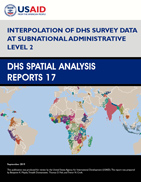- PUBLICATIONS
- JOURNAL ARTICLES
- ORDER PUBLICATIONS
Publications Summary
- Document Type
- Spatial Analysis Reports
- Publication Topic(s)
- Geographic Information
- Language
- English
- Recommended Citation
- Mayala, Benjamin. K., Trinadh Dontamsetti, Thomas. D. Fish, and Trevor N. Croft. 2019. Interpolation of DHS Survey Data at Subnational Administrative Level 2. DHS Spatial Analysis Reports No. 17. Rockville, Maryland, USA: ICF.
- Download Citation
- RIS format / Text format / Endnote format
- Publication Date
- September 2019
- Publication ID
- SAR17
Download
 Interpolation of DHS Survey Data at Subnational Administrative Level 2 (PDF, 3736K)
Interpolation of DHS Survey Data at Subnational Administrative Level 2 (PDF, 3736K)
